Learn how to make a sourdough starter with this easy recipe for beginners. All you need is flour and water, a little time and then use your ‘wild yeast’ to make bread and more!
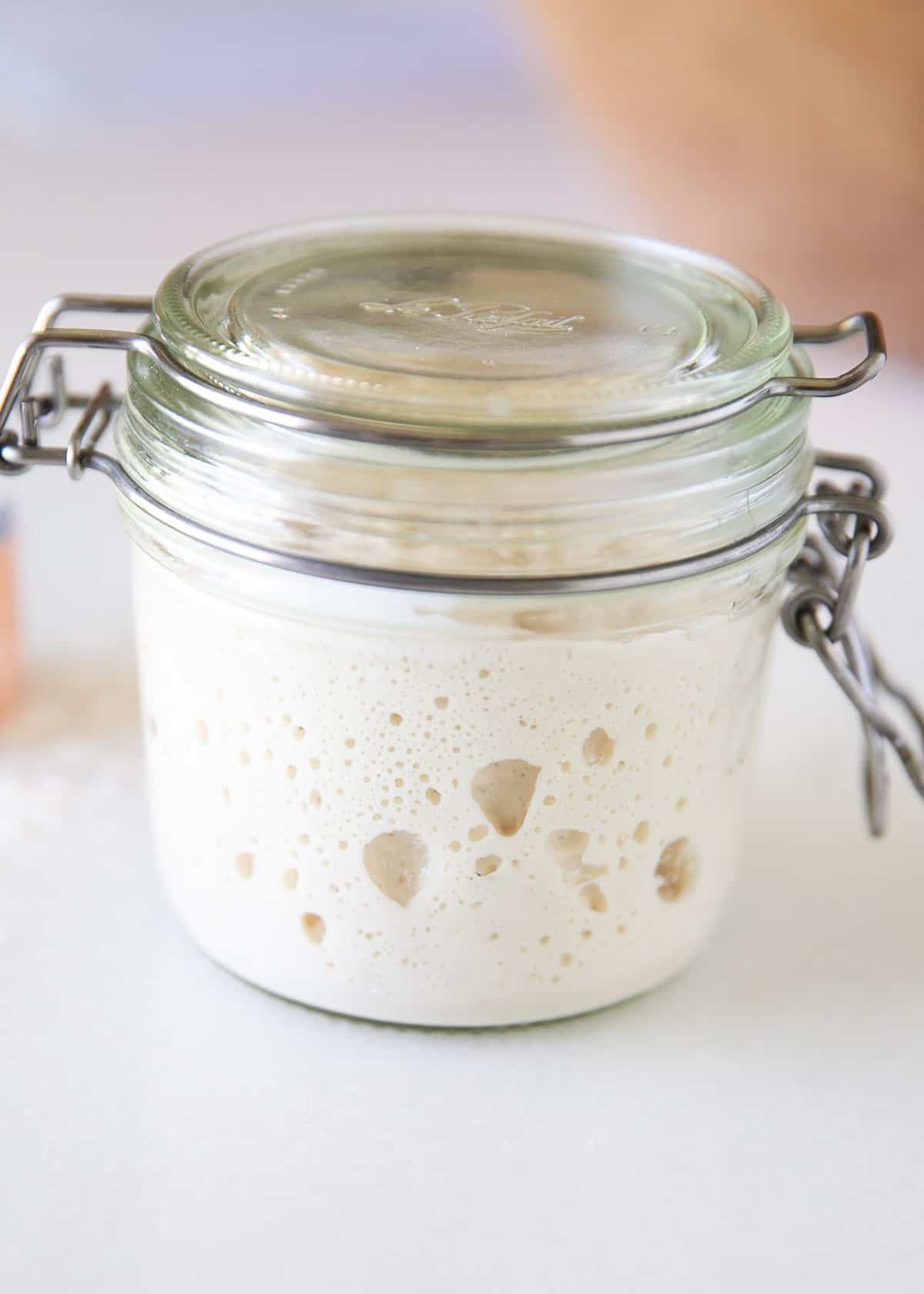
This post may contain affiliate links. Read disclosure policy.
Beginner Sourdough Starter from Scratch
If you want to make homemade sourdough bread, you will need to start with a sourdough starter. While it may seem a bit hard to do, it’s easier than you think to make your own starter from scratch, even if you are a beginner!
Using my easy-to-follow method and tips, your starter can be ready to use in about a week. Once your starter has been created, bake the best homemade sourdough bread or even my sourdough pancake recipe, waffles, sourdough crackers or pizza dough.
What is Sourdough Starter?
A sourdough starter is ‘wild yeast’. This is different from commercial yeast that is sold packaged at the grocery store as it is a living fermented culture consisting of flour and water.
Once these two ingredients combine, they start to feed off of the natural yeast and bacteria in your environment. Once active, a portion of your starter is added to your bread dough to make it rise.
The natural fermentation process is what gives the bread it’s flavor – that tangy, slight sour taste sourdough is known for!
Recipe Ingredients
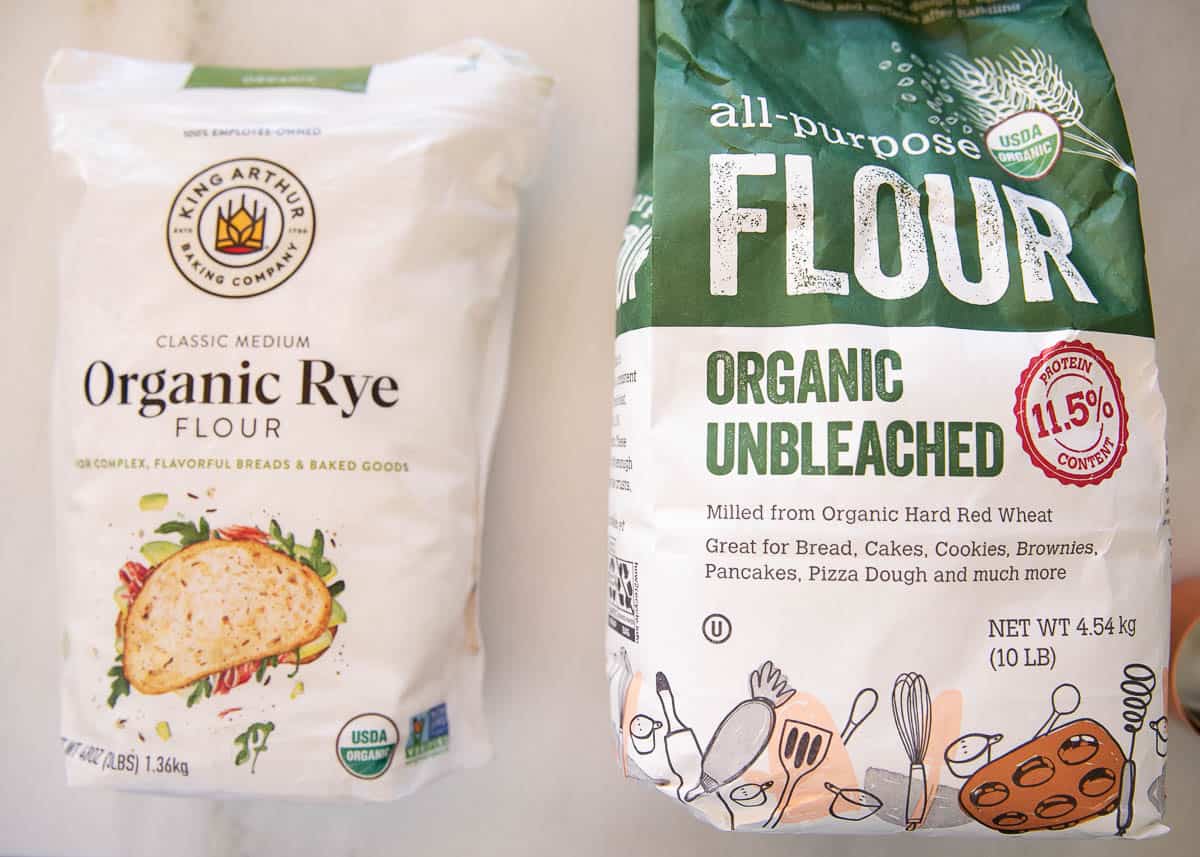
Find the full printable recipe with specific measurements below.
- Flour: I recommend starting your sourdough starter using rye flour, whole wheat or pumpernickel flour as whole grain flour will jumpstart the fermentation process. After the initial feeding, you will also need all-purpose flour.
- Filtered water: Unfiltered tap water often contains chlorine which will sabotage your starter. I like to use a water bottle or filtered water to feed it.
Equipment You’ll Need
- Large glass jar: Mason jars or a weck jar is needed to hold and cultivate the starter. I recommend having at least two jars.
- A cover for the container: A lid or breathable cloth work.
- Kitchen scale: While in most baking recipes you can get away without using a digital scale, for sourdough I like to use a scale for precise measurements and ratios.
- Spatula: An offset spatula or plastic spatula for combining and stirring the ingredients. I don’t recommend using a metal spoon as the metal can react with the natural yeast.
How to Make Sourdough Starter
With a little patience and using these step-by-step instructions, your sourdough bread starter can be ready in about 7 days.
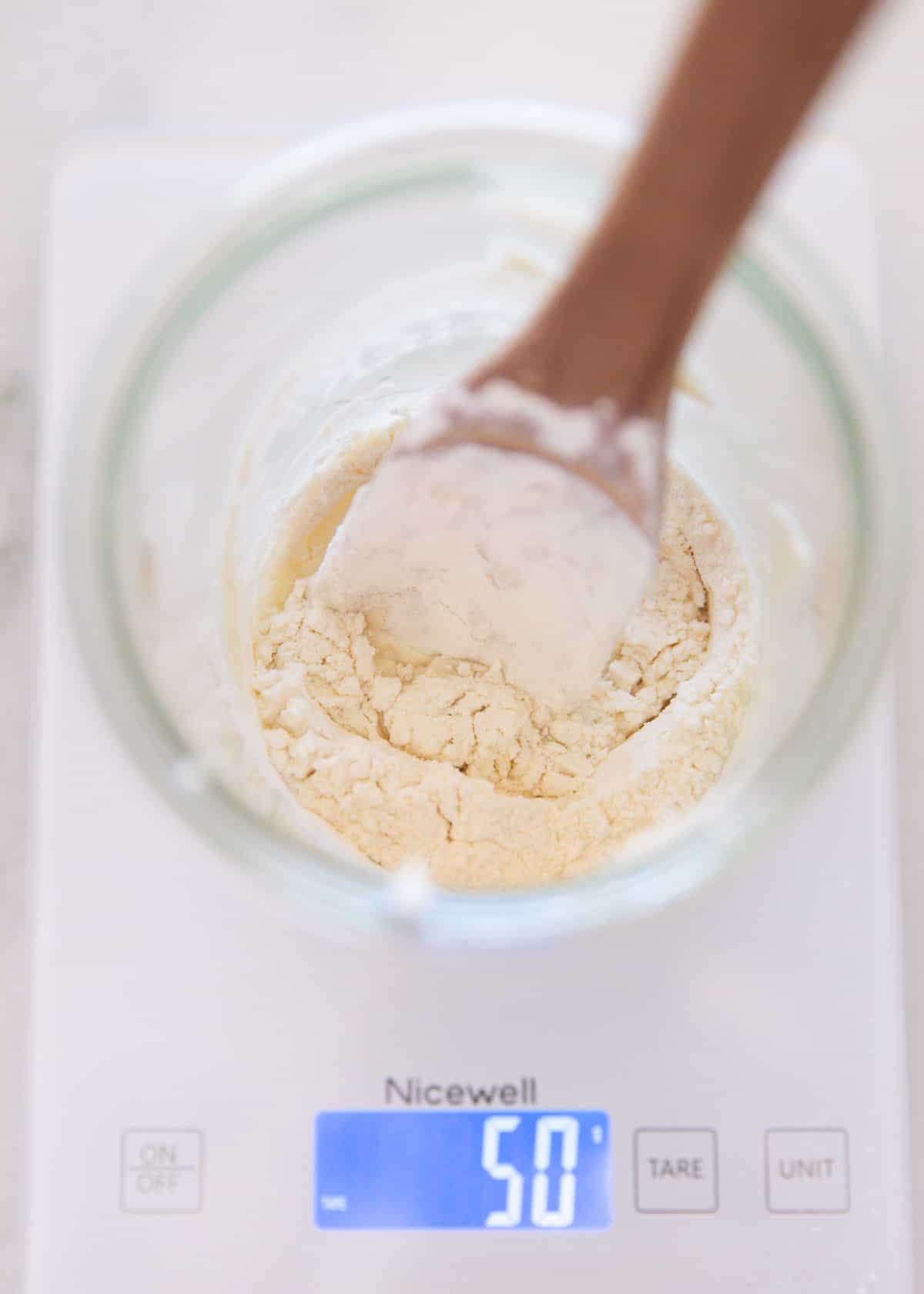
- Day one: Add 1/2 cup (60 g) rye flour and 1/4 cup (50g) water to a glass jar. Stir until combined. Cover loosely with a lid and keep in a warm spot (ideally 75-80°F) for 24 hours.
- Day two, three, four and five: Discard half of your starter from the jar. Add 1/2 cup (60 g) of all purpose flour and 1/4 cup (50 g) water. Mix well and cover.
- Day six: Place 100 grams of your starter in a new jar. Add about 2/3 cup (100 g) of all purpose flour and 1/3 cup (75 g) water to feed your starter. Mix well and cover.
- Day seven: Your starter should start to look bubbly and active and start to double in size after each feeding. Once it starts to double after feedings, it is ready to make a sourdough bread recipe!
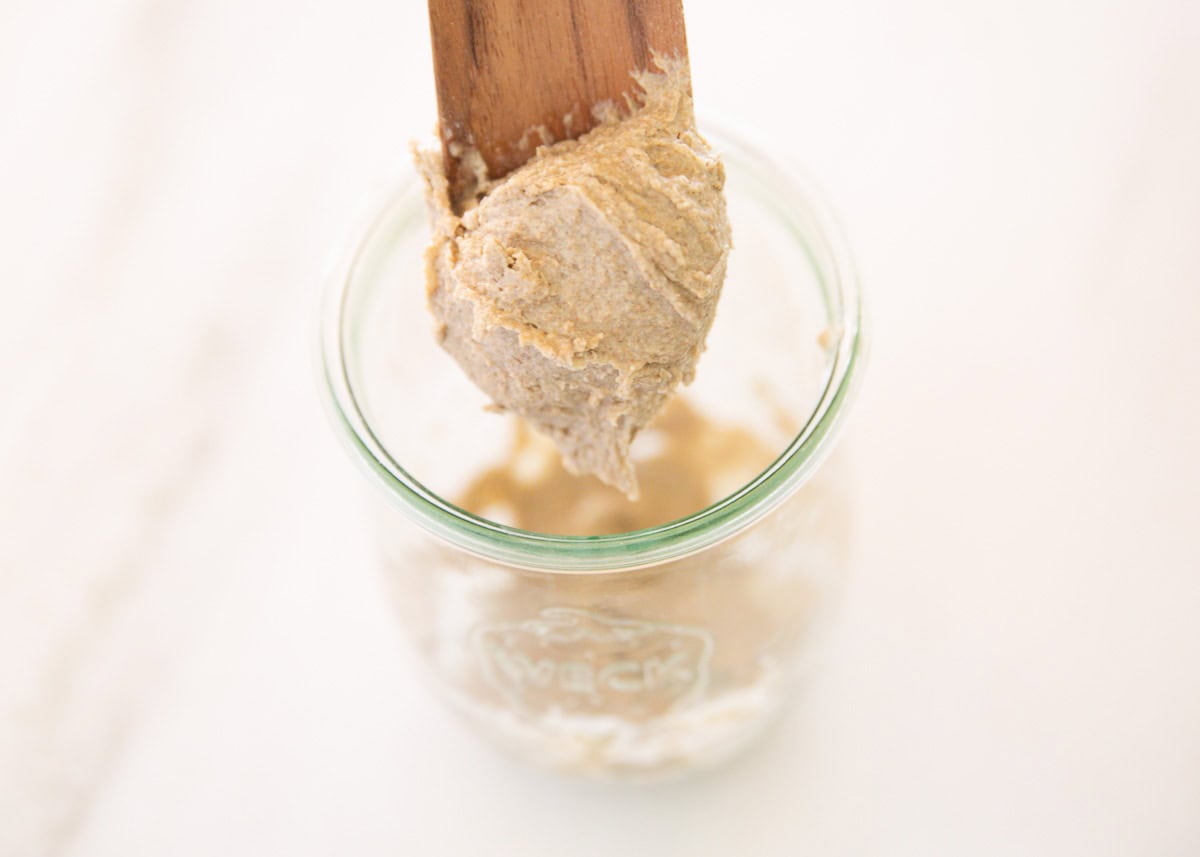
Maintaining and Feeding Sourdough Starter
Once your starter is alive and active, keep a simple maintenance and feeding schedule to keep it going for years and years!
- The first two weeks: For your starter to become more robust and strong, I advise to feed it flour and water daily for two weeks before storing in the fridge. Always discard half and then feed with fresh flour and water to keep bacteria and yeast in balance.
- Store in refrigerator: This is great if you only plan to bake a couple times a month. The cold of the fridge will slow down the fermentation process. If stored in the fridge, plan to feed your starter once a week. The day before you plan to bake, remove it from the fridge, discard and feed it so it’s good to go the next day!
- Store on the counter: If you plan to use your starter daily, it can be stored on your counter but then will also need to be fed daily! Each day discard half of the starter, and feed it with equal amounts flour and water.
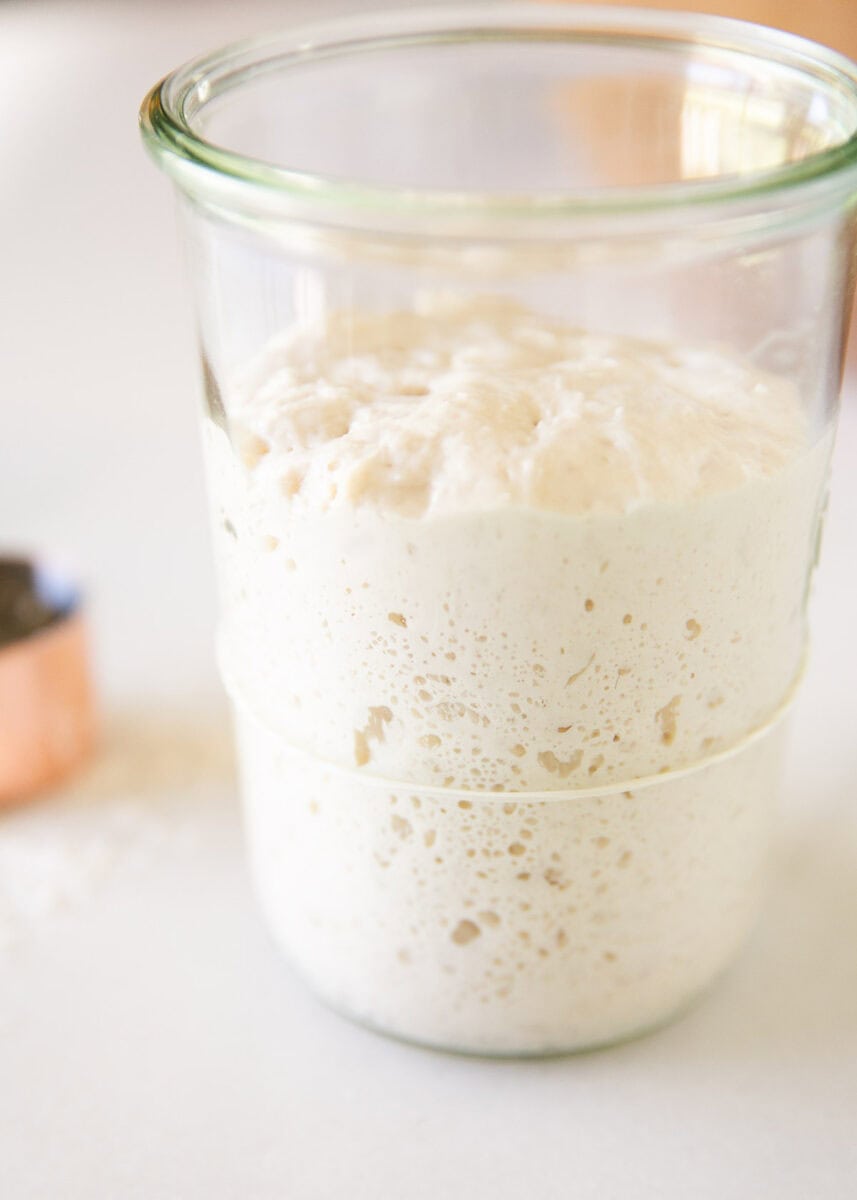
Making Sourdough Starter Tips
- Consistency: Establish a schedule to feed your starter on a consistent schedule around the same time on a daily basis.
- Warm spot: If your starter is cold, it will take longer to activate. If you have a proofing box, that works, but you can also place starter in the oven with the light on or in the microwave with the door slightly ajar so the light stays on. Ideally, your starter thrives best in 75°F-80°F temps.
- Room temperature filtered water: Tap water or unfiltered water may contain additional chemicals that will hinder your starter from growing. Use room temperature or slightly warm filtered water.
- Slow starter: On day four if your starter seems a little slow to start, after 12 hours, you can add another 2 Tablespoons of rye flour and two teaspoons of water to feed it a little more.
- Use a rubber band. Measure your starter growth by placing a rubber band around the outside of the jar. It’s an easy way to track the rise and growth of the starter each day.
- Hooch: If a brown liquid develops on top of the starter during the initial process, this is known as hooch. It is an indication that your starter needs to be fed! Pour off the hooch and top layer of the starter to discard it before feeding.
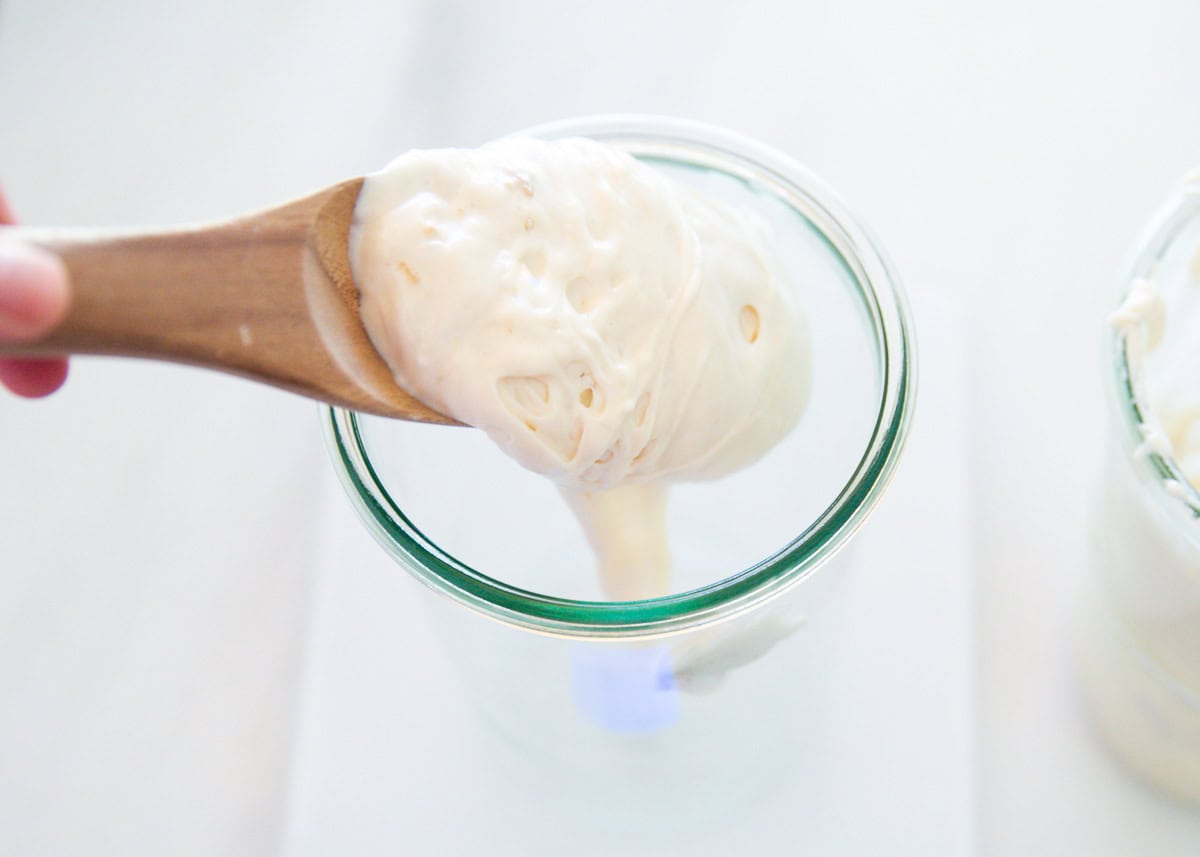
Storing Your Sourdough Starter
- Unless you’ll be baking with it daily, keep your starter in a covered jar in the fridge. This puts the fermentation on a slow simmer, and you only need to feed it when you’re ready to bake.
- I feed my start one to two times a month, if I don’t plan on baking it, I don’t bring it to room temperature, I just discard, feed and place it back in the fridge.
- If I am planning on baking, I remove it from the fridge, bring it to room temperature then discard and feed it usually 24 hours before I plan on using it to make bread.
Need more sourdough recipes? Try sourdough pancakes, this sourdough waffle recipe and sourdough discard chocolate chip cookies!
More Homemade Bread Recipes
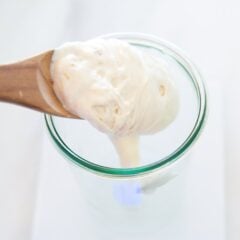
Sourdough Starter Recipe
Video
Equipment
Ingredients
To begin your starter
- ½ cup (55 g) rye flour , whole wheat or pumpernickel
- ¼ cup (50 g) filtered room temperature water
To feed your starter
- ½ cup (60 g) all-purpose unbleached flour , or bread flour
- ¼ cup (50 g) filtered room temperature water
Instructions
- Establish a feed time: Before you begin this process, establish the time you will feed your starter every day that works well with your schedule (you will feed about every 24 hours).
- Day one: Add 1/2 cup (60 g) rye flour (or whole wheat) and 1/4 cup (50g) water to a glass jar. Stir until combined. Cover loosely with a lid and keep in a warm spot (ideally 75-80°F) for 24 hours.
- Day 2, 3,4,5: Remove half of your starter from the jar. Add 1/2 cup (60 g) of all purpose flour and 1/4 cup (50 g) water. Mix well and cover. Each day the yeast will continue to grow and more bubbles should appear.
- Day six: Place 100 grams of your starter in a new jar. Then add about 2/3 cup (100 g) of all purpose flour and 1/3 cup (75 g) water to feed your starter. Mix well and cover. Place a rubberband or piece of tape on the jar to measure the growth. Today it should double in size.
- Day seven: Today your starter should be nice and active. If it isn't, you can give it one more day and add in half rye flour. About four hours before you'd like to begin baking give it one last feed. Once it has doubled in size and is very bubbly you can use this starter to bake with. *Make sure to leave 1/4 cup starter in the jar and feed again so you'll always have starter.
- Store: Feed your starter and you can leave it on the counter if you plan to use again the next day or you can store it in the refrigerator until you're ready to activate it again.
Last step: Please leave a comment and rating after you make the recipe.
Notes
Nutrition
Nutrition provided is an estimate. It will vary based on specific ingredients used.
Recipe FAQs
Your starter will be ready in as little to 7-10 days but could take up to two weeks. The warmth of your home plays a huge part in how fast it takes to cultivate the starter.
You will know the starter is ready to bake with once it is doubling in size a few hours after you have fed it. I recommend using a rubber band to mark on the jar where your starter is before feeding so you can visually see when it has doubled.
Some may like to use a float test as well to ensure it’s ready. Take a small portion of the start and drop it into a bowl of water. If it floats in the liquid, it’s ready. If it sinks, your starter needs more time.
A warm spot helps facilitate fermentation! Here are a few ways to create a warm spot in your home. Place it in the oven with the light on (but be careful to not turn on the oven!), use a heating pad on the lowest setting, place near the oven while the oven is on, place near a sunny window or on top of the refrigerator!
This keeps the balance of the wild yeast and bacteria balanced. It also prevents the starter from developing an overly sour taste as well makes it more manageable to maintain over a long time.
Initially you may not want to keep the discard (it can taste weird), but after you starter is alive and well, you can save the discard in a separate jar in the fridge and use it to make a variety of sourdough discard recipes.


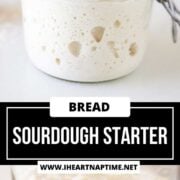
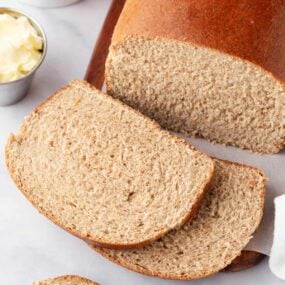
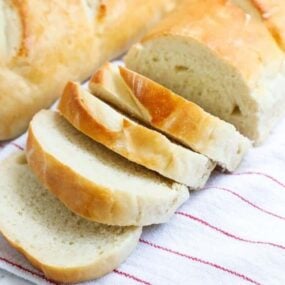
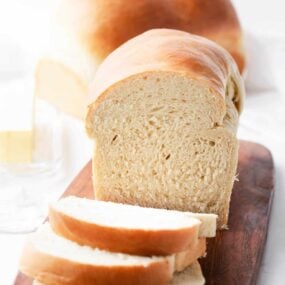
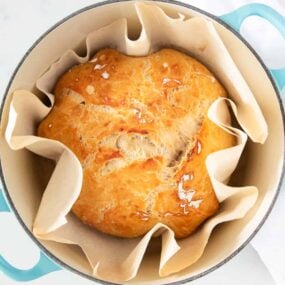

Joy
Followed Day 6 instructions. There were a few bubbles before I was following day 6. If I wanted to feed it for a couple more days, what is the ratio of starter, flour and water. Thanks!
Jamielyn Nye
Glad it’s starting to grow! Yes, the longer it grows the better. You’ll use the same feeding ratio as day 6 moving forward :)
Rosie
Could I use whole wheat flour (ground from soft white wheat berries) instead of all purpose flour?
Jamielyn Nye
Yes you could. If it’s not growing, try mixing up the flour.
Kris C
I have been wanting to do this for so long, but was SO intimidated. Your instructions made the process easy for me and it turned out! YAY!
Nina
Thank you for sharing this guide. It is really easy to follow and the tips were helpful. The bread I made came out perfect. I also love that it has a long storage life.
I Heart Naptime Community
I’m so happy your bread turned out delicious! Happy baking :)
Val Fiore
Amazing! This was my first time so I was nervous. I used whole wheat and it was so easy.